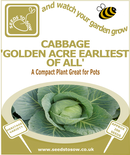Description
An excellent early summer ball head cabbage produced on a compact plant which is great for successional sowing and will mature in approximately 10 weeks. it is therefore, perfect for pots as well as the main vegetable plot.
The tight green heads have great texture and flavour and are delicious cooked or shredded raw in salads.
| When to sow | Sow successionally from February to June. Early sowings should be under a cloche, in a propagator on a windowsill or in a greenhouse. |
| Where to Sow | Sow seed thinly in a prepared seed bed in shallow drills 1.5cm (3/4") deep. Keep well watered. Once the seeds have germinated, thin the seedlings to 8cm (3in) between each plant ensuring they are planted firmly and deep to anchor them in the soil. |
| What to do Next | When the seedlings are between 6 and 8cm high ( 2.5 to 3in) high they are ready for transplanting to their final growing site. Water well the day before transplanting. |
| Harvest | June to October. |
| Handy Tips | Cover young plants with a protective netting or fleece to prevent attack from birds and insects. Place a collar around the stem of each plant to prevent cabbage root fly attacks. |
| Companion Planting | Mint: Useful against Cabbage White Butterflies, Aphids and Flea Beetles, Thyme: To ward off Cabbage worm. Also useful: Sage, Oregano, and Nasturtium. |
| Nutritional Information | Excellent source of vitamins A, C and B, Iron and Potassium. The darkest leaves contain the most nutrients. Low in calories! |
| Serving Suggestion | Pick the tender Spring Greens and sauté in butter or serve with garlic and lemon juice. The use for the mature cabbages are endless - a few suggestions would be to use them in coleslaw, a stir fry, spring rolls ,soups and stews. |
Payment & Security
Your payment information is processed securely. We do not store credit card details nor have access to your credit card information.






